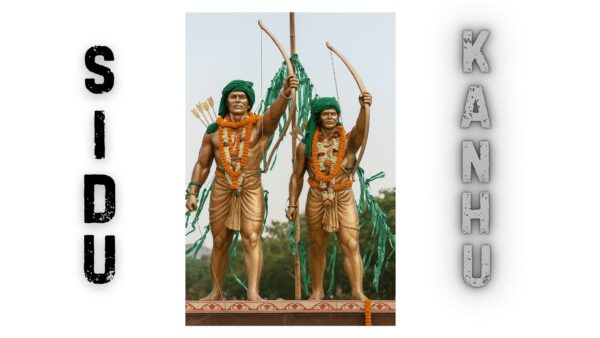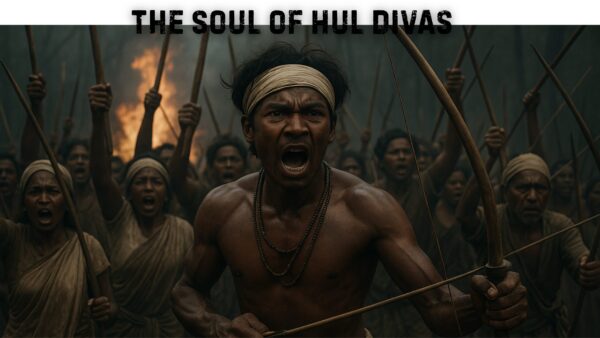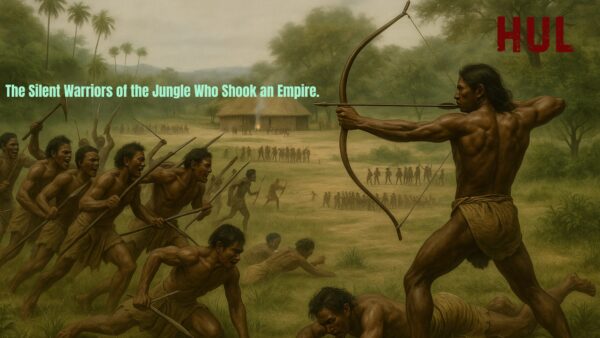Hul Diwas, celebrated every year on June 30, stands as a powerful symbol for the tribals of India. It honours the Santhal Rebellion of 1855, a crucial yet often overlooked event in our history, led by the courageous Santhal leaders Sidhu and Kanhu Murmu. This rebellion, one of the earliest large-scale uprisings in India, predates the Indian Rebellion of 1857 and saw thousands of tribal Santhals in present-day Jharkhand rise against British colonial oppression and exploitation.
It’s essential to understand that the bloodshed experienced by tribal communities was a profound act of resistance rather than mere oppression or slavery. Hul Diwas is not just a day of remembrance; it is a robust celebration of tribal courage, identity, and resilience. This article will delve into the history, legacy, and cultural significance of Hul Diwas, reaffirming its importance in today’s context.
Who Are the Santhals?

The Santhal tribe stands as one of the largest and most prominent tribal communities in India, predominantly found in Jharkhand, Bihar, West Bengal, Odisha, and Assam. Celebrated for their vibrant music, dynamic folk dances, and rich oral traditions, the Santhals maintain a powerful connection with nature. Their cultural identity has not only endured but thrived for centuries, even in the face of colonization and marginalization.
By the mid-19th century, after the British colonization of India, the Santhals faced exploitation from colonialists and their allies, landlords, moneylenders, and traders. Their natural resources were seized, and their agricultural systems disrupted, reducing them to labourers. This rising discontent sparked one of the earliest and most courageous rebellions against British rule.
What Led to Hul Diwas: The Untold Roots of the Rebellion
Tribal communities have a rich history and continue to exist today. Worldwide, they inherently resist oppression and slavery, as seen in the events of Hull Day in 1855, which reflected a long-standing struggle for dignity and justice.
The situation was the result of years of exploitation, oppression, and betrayal faced by the Santhal community. Under British rule, the British seized tribal lands and transferred them to landlords and moneylenders, who exploited the Santhals by imposing heavy taxes and forcing them to work as labourers. Their habitats were cleared of forests, and their mineral wealth was taken away. Exploitation reached its peak during this time, leading to the destruction of traditional livelihoods and the marginalization of their cultural identity.
The Santhals are innocent and peaceful people, but they suffer from economic hardship and social shame. This situation is hard to believe. The legal system supports British officials and landlords, which leaves the tribals without a voice or justice. The tribals see the land as their father and as God, and they are willing to give their lives for it.Land grabs, debt traps, and the loss of cultural identity caused a lot of tension. This tension led to a rebellion led by Sidhu and Kanhu Murmu. We now celebrate this event as Hul Diwas, a symbol of tribal resistance and courage.
Sidhu-Kanhu’s Call for Freedom: The Soul of Hul Divas

In the midst of the Hul Diwas incident, two bold tribal brothers from Santhal land took a defiant stand against the formidable British Empire, shaking its very foundations. Their names were Sidhu and Kanhu Murmu, and their courage left an indelible mark on history.
Sidhu and Kanhu Murmu were fearless leaders of the Santhal tribe who ignited the historic Santhal Hul (rebellion) of 1855. Born in Bhognadih, present-day Jharkhand, they stood resolutely against the oppressive feudal moneylender system and the treacherous policies of the British, demonstrating the true spirit of resilience and courage.
On June 30, 1855, he played a pivotal role in galvanizing over 10,000 Santhals in their pursuit of land, dignity, and self-determination. This significant day is now commemorated as Hul Diwas, representing a testament to tribal resilience and courage.
The story of tribal communities often remains untold, and when it has been recorded, it is frequently overlooked. This silence is palpable in the enduring call for independence voiced by leaders like Sidhu and Kanhu, which still resonates deeply through tribal folk songs, folklore, and the fabric of tribal identity. Hul Day represents more than just a moment in history; it embodies a powerful movement rooted in the struggle for tribal identity and self-expression. It’s important to honour and acknowledge these voices and their enduring legacy.
Hul Diwas Today: Remembering the Unsung Tribal Heroes
In today’s discourse on history, events like the Jallianwala Bagh massacre are well-known. However, the even more shocking massacre of the Hul Rebellion remains largely overlooked. This significant event has persevered through tribal dialects, folklore, and folk songs, yet it deserves a prominent place in our historical narrative. Educated tribal elders and dedicated organizations are actively working to illuminate this dark chapter and ensure it is recognized in history. Decades may have passed, but the indomitable spirit of the Hul Rebellion continues to thrive in the hearts of India’s forests, villages, and tribal communities.
Every year on June 30, tribal communities from Jharkhand, West Bengal, Odisha, and Assam unite to honor the legacies of Sidhu, Kanhu, Chand, Bhairav, and other revered martyrs. This significant occasion has now expanded to include participation from tribal organizations across all states of India, reflecting the strong sense of solidarity within the tribal community.
The day is commemorated with various activities, including rallies, folk dances, tribal songs, and speeches, fostering an atmosphere of remembrance and mutual respect.Today, statues, monuments, and even the names of universities commemorate their sacrifices. However, many tribal voices argue that Hul Diwas does not receive adequate recognition at the national level. Unfortunately, due to political reasons, tribal sacrifices still need to be validated today.
Tribal art, stories, and oral history keep the memory of Hul alive. It’s not just another date; it marks a tough time for the tribal community and stands for resistance, pride, and identity. Hul Day reminds us that history isn’t only found in books; it’s deeply felt by those who choose pride over fear. That’s what makes a true tribal spirit.
Hul Diwas 1855: Chronology of the Rebellion
Hul Diwas, on 30 June 1855, is an important day in the history of India’s tribal communities. This day marks the Santhal rebellion against British exploitation, which is often ignored in history books. The Santhal tribes, led by Sidhu-Kanhu Murmu, began an organized fight against British rule, the landlord system, and the moneylenders’ exploitation. We will look closely at the events of 30 June 1855.
Estimated morning (6:00 AM – 9:00 AM):
Thousands of Santhal tribesmen gathered in Bhaganadih, now Sahibganj, Jharkhand, after months of hard work.The meeting was opened by Sido-Kanhu Murmu in the name of nature.Siddharth Murmu’s statement:
“We’re proud to say that the Santhals are ready to create our own rule, free from the British and moneylenders. Together, we promise to stand united in peace.”
Approximate time (10:00 AM – 2:00 PM):
The message spread through villages: “Fight injustice!” The tribes people prepared to revolt with bows, arrows, axes, and knives. They attacked moneylenders’ and landlords’ homes, leading to looting, document burning, and land grabbing.
Estimated Evening Hours: 3:00 PM – 6:00 PM
The rebellion spread to regions such as Rajmahal, Pakaria, Barhet, Nalhati, and Bhagalpur, gaining momentum rapidly. In response to attacks by Sidhu and Kanhu’s followers on British police posts, the British authorities deployed additional military troops to the area.
Evening (6:00 PM – 8:00 PM):
The Santhals captured Bhaganadih and the nearby areas, prompting British officers and some landowners to flee. As the Santhal rebel groups moved from village to village, their unity became increasingly evident.
Night (8:00 PM – 12:00 AM):
The rebellion plan was finalised. Sidhu, Kanhu, and their brothers Chand and Bhairav divided the region into four parts to spread their cause strategically. This approach was vital to their success. The Santhal rebellion ignited a spirit that persevered for several months.
This day marked the start of tribal conflict, with over 20,000 lives lost, though reports only confirmed 10,000 to 15,000. The Battle of Hull was the first major tribal uprising in India’s independence movement.
Unsung Heroes of the Santhal Rebellion: Voices Lost in History
Today, there are many famous and anonymous tribal martyrs, but why are they not named in history?
The British intentionally suppressed specific names to prevent tribal communities from organising, fully aware that such unity would threaten their control. This strategy, rooted in politics, is still prevalent today. Our elders successfully broke free from the white British, yet the influence of the black British continues to persist.Mainstream history often overlooks local leaders, but tribal folklore reveals their true stories.
Chand Murmu and Bhairav Murmu
The individuals mentioned were the younger brothers of Sido and Kanhu.They played a vital role in shaping our strategy and inspiring our leadership.They organized movements for change in many regions and ultimately became martyrs for their cause.
Phulo Murmu and Jhano Murmu
Two notable women warriors, remembered in tribal folklore, stood alongside men in unwavering support of the rebellion.They fought fiercely, organized women, and led the rebellion. Fulo-Zano bravely confronted British soldiers and became a martyr for freedom.
Nuba Soren
A notable warrior organized the people in the Jharkhand region during the rebellion. His name is not known in history. He worked selflessly to unite society.Under his leadership, there was a concerted effort to address the challenges posed by moneylenders and landlords. This initiative resulted in the significant reform of the landlord system in a number of villages.
He was later captured by the British army and killed in secret. No evidence supports this claim.
Mazeer Tudu
Folk singers and preachers have played an essential role in sharing the message of rebellion through their songs across various villages. Their influence continues to awaken and inspire communities, fostering a deeper understanding of important issues. There’s little need for further elaboration; their contributions are indeed noteworthy.
Due to propagandists like these, the conflict became one of arms, culture, and consciousness.
Gulali Baske
A courageous woman from the Santhal region participated in the rebellion and killed a British officer. Her bravery during that time was truly commendable. What extent will tribals go to when their endurance is pushed to its limits? She was arrested and hanged, yet her name continues to live on in folk songs and folklore.
The time has come when we have to give these unsung heroes their place in history. It is our responsibility to pass on their sacrifices and sacrifices to future generations.
Honouring the Forgotten Flames of Hul Diwas

Whenever we talk about Hul Diwas, pay tribute on June 30, or express our grief on social media, names like Sidhu and Kanhu Murmu rightfully command our attention. Yet, lurking in the shadows of history are countless heroes and heroines whose contributions are equally significant. Take, for example, the fearless Phulo Murmu and Jhano Murmutwo tribal sisters who bravely took up arms during a time when society deemed women inferior and expected them to be mere onlookers.
Their courageous role in the Santhal Rebellion of 1855 is a powerful testament to their strength and resilience, lighting a flame that continues to burn brightly in the hearts of tribal people today. It is time we acknowledge their invaluable legacy, which mainstream history has too often chosen to ignore.
Phulo and Jhano were courageous daughters of the soil who rose against injustice. Armed with traditional weapons, they led tribal women in dismantling British outposts. In a time when women leading rebellions was unthinkable, they became symbols of resistance and pride.
The forests of Santhal Parganas echoed with nameless warriors, farmers, singers, and mothers who participated in the Hull. Their voices, silenced by history, endure through folk songs and tribal memory. Honoring these overlooked figures involves recognizing their contributions to India’s freedom struggle. We must move beyond textbooks to acknowledge the true diversity of our revolutionary history.
Phulo and Zano illustrate that freedom is earned through sacrifice, often by those we forget.
What is Hul Diwas and why is it celebrated on 30 June?
Hul Diwas commemorates the Santhal Rebellion on 30 June 1855 against British rule and landlords, highlighting Adivasi resistance.
Why is Hul Diwas celebrated on 30 June?
Hul Diwas, celebrated on June 30, honors the 1855 Santhal uprising by Sidhu and Kanhu Murmu against British rule.
In which states is Hul Diwas mainly celebrated?
Hul Diwas is primarily celebrated in the tribal regions of Jharkhand, West Bengal, Odisha, Bihar, and Assam, with Jharkhand being the central hub. Bhognadih village serves as the historic focal point.
What is the historical significance of Hul Diwas?
Hul Diwas commemorates the 1855 Santhal Rebellion, one of the earliest tribal uprisings against British colonial rule and the exploitation by landlords. This event highlights the courage and resistance of Adivasi communities in India’s struggle for freedom.
Is Hul Diwas still celebrated today?
Hul Diwas is celebrated annually on June 30, particularly in tribal areas. The day is officially recognised and features cultural events along with tributes from community leaders and government officials.
How is Hul Diwas related to India’s freedom movement?
Hul Diwas is an important event in India’s history, marking the Santhal Rebellion of 1855, one of the first organised challenges to British rule. This uprising laid the foundation for later movements and highlighted the vital role of Adivasi communities in the struggle for independence.
Conclusion:Remembering the Legacy of Hul Diwas, 30 June
June 30, known as Hul Diwas, stands as a powerful symbol of tribal resistance, unity, and sacrifice. The Santhal Rebellion of 1855, led by the indomitable Sidhu and Kanhu Murmu, was one of the first organised uprisings against British colonial rule and social injustice. This pivotal struggle confronted the exploitation perpetrated by landowners, usurpers, tax collectors, and oppressors.
This historic movement has left an indelible mark, inspiring generations and showcasing the unwavering courage of tribal communities who bravely fought for their rights. Hul Diwas today serves as a vital moment of reflection and recognition. It calls upon the nation to honour these unsung heroes and to weave their narratives into the fabric of India’s freedom struggle. As we celebrate Hul Diwas on June 30, let us ensure that their remarkable legacy endures, not just in history books, but in our collective consciousness and shared identity.
As we celebrate Hull Day, let us commit to honouring their legacy by sharing their stories, recognising their contributions, and ensuring their voices are heard. The spirit of Hull endures and continues to inspire social justice, resistance, and pride in tribal identity from one generation to the next.
One British officer reportedly wrote:
“The Santhal insurrection is unlike any we have witnessed before — not of scattered mutiny, but of a united people with a cause. They are not mere savages; they fight with unmatched courage, as if death holds no fear for them.”
This powerful admission by the colonial side shows how deeply the Santhal rebellion shook British confidence.
Your feedback means a lot to us.
If you have any questions, suggestions, or concerns feel free to leave a comment below. We’re here to listen, grow, and improve together.
Thank you for being a part of this journey

